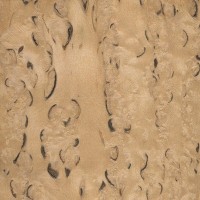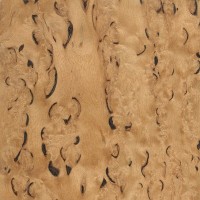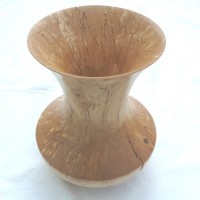Masur Birch is not a particular species of birch, but is rather a grain figure that is most commonly seen in Downy Birch and Silver Birch. It is also sometimes known as Karelian Birch—with Karelia being a region between Finland and Russia. Once surmised to have been caused by the boring larvae of a certain beetle, Masur Birch in Norway has been shown to be hereditary, classifying the name of the variant as Betula pendula var. Carelica. Regardless of the exact cause and makeup of the peculiar grain pattern, the resulting figure and appearance is very similar to burl wood or birdseye maple, though of a different origin. Masur Birch is commonly used for turned objects, decorative veneer, knife handles, and other small specialty items.
A special thanks to Steve Earis for providing the wood sample and turned photo of this wood species.







Here’s a Masur birch knife handle, no sealant. Just burnished to ~15k grit with fine sanding pads.
Here are a couple more photos of turnings in Masur birch.
work of art, beautiful
a turned rattle from masur birch
Contradictory to the text above, only Betula pendula can develop true “masur”.
It may have to do with a misconception that Betula pubescens too is listed, as “masur” is a common name for regular burls, which do occur on both species quite commonly i believe.
However true “masur” runs through the entire tree and is not localized.
If I’m wrong, please feel free to correct me.
This wood is beutiful with a fabulus lustre and chatoansy, but difficult to work with tearout is unavoidible and its much harder than ordinary birch, heavier too.
Be prepared to sand…..
Turned box with lid, made from Karelian Birch
In karelia there are farms of Masur birch. There are auctions of trunks for several veneer producers and availability is controlled not to “cook” market with this rare material. Becasue of very small tree diameter veneer sheets are short and only rotary cut to show best figure ( like in birds eye maple). Clonal sellection of local growers yields with plants with this genetic sign. You can buy small plant of Betula carelica online. Newest Scandinavian and Russian research showed that Masur Birch figure is genetic and is connected with contaminated sugar distribution near branches. Also research on existing farms… Read more »
I have a rifle stock made from White Birch laminated wood from Czechoslovakia which is absolutely beautiful.
You can buy plants and grow masur birch (it is genetic no larvae)
I’m actually about to make a knife using this variety as the scales for the first time. It’s absolutely gorgeous when brought to a shine, and friends who have used it say it takes a polish all the way up to the 9 micron grit level.
Can’t wait until I can work with it myself.
ive bought a knife from russia made by A&R called a oprichnik..it has wood of this type for a handle..beautiful. They described it as a very hard wood and durable BECAUSE the knots are in the wood. i could have had it with a birch bark or walnut handle but this kind of wood looks great on this knife
This grain pattern looks just like what the Sonor drum company used for their old Sonorlite drums back in the 80’s. They advertised it as “Scandinavian Birch”. Great sounding drums, I know that!
Actually the pattern in masur birch is not from any form of larvae. Masur birch is a genetic “sick” type of birch which has been around for ages. The pattern comes from the bark and/or knots growing into the tree instead of out of it. I dont know where the rumor that larvae made the pattern comes from, but it is absolutely not true. I know many people who have grown their own masur and they have never seen any larvae. Also there has been much research done on masur birch in norway since we have a long tradition of… Read more »